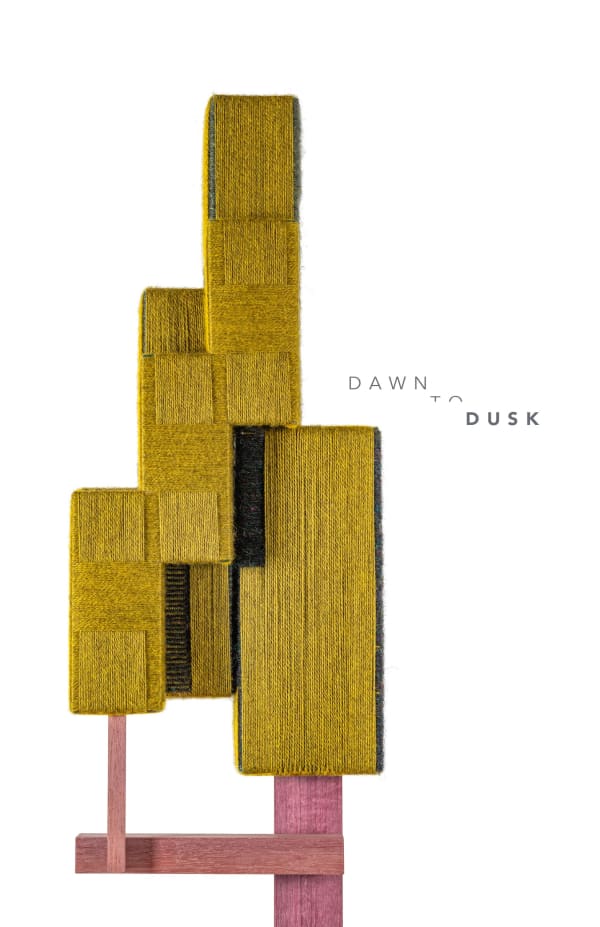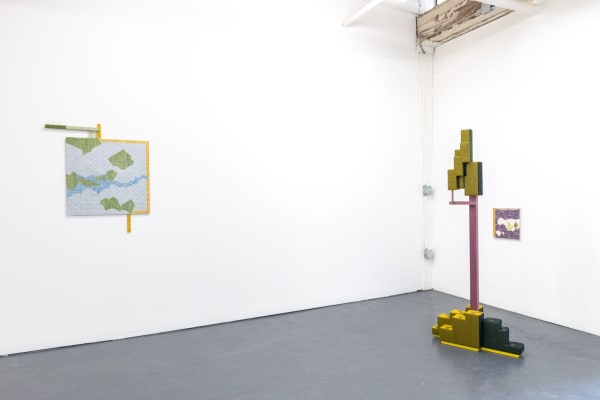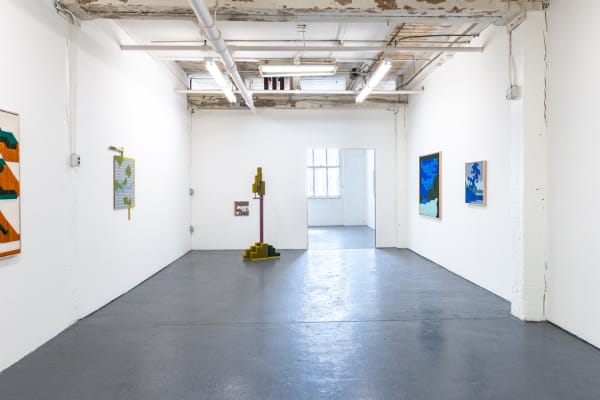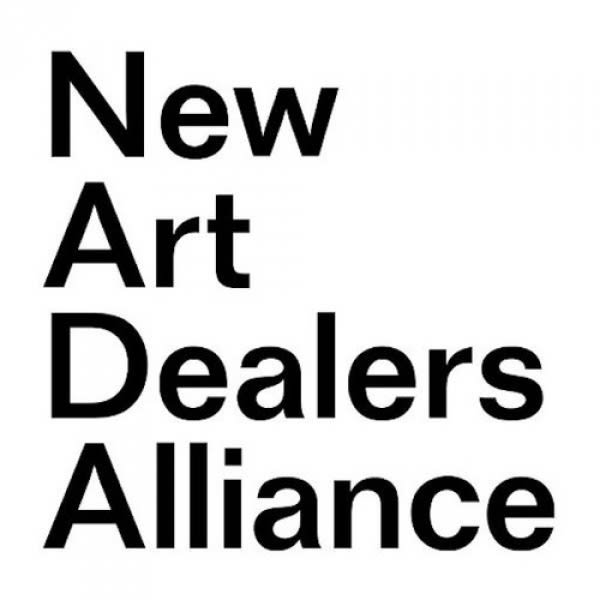goldfinch presents new work by azadeh gholizadeh
nada miami 2023
booth A-106
Goldfinch is proud to present a solo booth of works by the Seattle-based Iranian artist Azadeh Gholizadeh (she/her), whose needlepoint tapestries explore and draw upon ideas about light, time, color and memory; Modern architecture and modernist grids; digital versus analog perspectives; the history of women-centric fiber art techniques; the design of Persian manuscripts such as the Shah Nama, and Persian gardens and mosques. Through these tapestries, Gholizadeh imagines alternative ways of situating marginalized bodies and queered perspectives within shifting landscapes, while also depicting the fragmentation of memory that occurs when the place(s) where one has formed their core identity, their “homeland” (be it literal or metaphorical), have become inaccessible.
This booth was selected for inclusion in TD Bank Curated Spotlight, curated by Jenée-Daria Strand, Assistant Curator at Public Art Fund. We are in Booth A-106.
-
 Azadeh Gholizadeh, The Bay, 2023
Azadeh Gholizadeh, The Bay, 2023 -
 Azadeh Gholizadeh, Fall, 2023
Azadeh Gholizadeh, Fall, 2023 -
 Azadeh Gholizadeh, Bonsai Rock, 2023
Azadeh Gholizadeh, Bonsai Rock, 2023 -
 Azadeh Gholizadeh, Moss, 2023
Azadeh Gholizadeh, Moss, 2023 -
 Azadeh Gholizadeh, Fireflies, 2023
Azadeh Gholizadeh, Fireflies, 2023 -
 Azadeh Gholizadeh, Clouds: Puget Sound, 2023
Azadeh Gholizadeh, Clouds: Puget Sound, 2023 -
 Azadeh Gholizadeh, Viridian , 2023
Azadeh Gholizadeh, Viridian , 2023 -
 Azadeh Gholizadeh, Citron Yellow, 2023
Azadeh Gholizadeh, Citron Yellow, 2023 -
 Azadeh Gholizadeh, Yellow Ochre, 2023
Azadeh Gholizadeh, Yellow Ochre, 2023
-
Artist Statement
"In my current practice, I explore the body, landscape, and fragmentation of memory by examining my emotional connection to belonging. I am interested in the relationship between landscape and crafts as platforms that carry personal and emotional meanings. In a world with increasing barriers to my body due to its geographical identity, sexuality, and gender, these voyages to lands both remembered and imagined remind me not only who I am but who I can be, a journey toward home. Inspired by the experience of looking out the window, I make tapestries combing my observation with the echoes of my memories."
-
Video
The artist at work -
Trees as a Recurring Motif
-
“I like looking at trees to explore how absence and distance, desire and a longing for that which is absent can become a form of endurance,” and pain can be transformed into a conversation between past and present, says Azadeh Gholizadeh. “I use elements from nature such as clouds, mountain peaks, forests, and leaves because they give me comfort and a sense of refuge. They resonate because one or more components awaken some of my memories, and when all are combined, (they) create a new view.” In this way, Gholizadeh says, she seeks to portray the relationship of landscape to memory in a manner described by Simon Schama as “a way of rediscovering what we already have … instead of being yet another explanation of what we have lost, it is an exploration of what we may find.”
-
Azadeh Gholizadeh Studio
-
The Artist's Process
Gholizadeh’s needlepoint tapestries and sculptural installations insist that landscapes, pictorial notions of perspective, and hand weaving and embroidery practices are all carriers of subjective emotional meaning. The tapestries, which typically follow a basic square or rectangular format, are inspired by Gholizadeh’s experiences looking out at present-day views that may simultaneously spur memories of her past and her family in Tehran, Iran, combined with observations derived from Gholizadeh’s present locale(s).
Gholizadeh’s process begins by making a collage out of two or more photographic images so as to combine different viewpoints and depths into a single plane. Then, based on the structure of lines and patterns in the collage study, as well as inspiration she may draw from, for example, Islamic geometric patterns found in the Persian gardens and mosques she studied as an architect in Iran, Gholizadeh uses yarn, felt and painted canvas mesh to create ambitious tapestries, staying within a framework of horizontal and vertical lines so that the final imagery may appear pixelated. “This is how I reflect on the idea of home,” Gholizadeh explains. ”[It is something that is] fragile, inconsistent, and perspectival.”
-
What inspired you to get started on this body of work?
AG: This whole body of work started a few years experimenting with materials and the idea of borders and boundaries. I made a weaving, and I fell in love with image making within a surface structure. Not having a border to start with made me look beyond a constrained area. Additionally, the act of connecting two points with thread became a metaphor reflecting my situation as an Iranian immigrant. And of course, I very much enjoyed the repetitive process and meditative qualities.
-
How did you get into making art?
Azadeh Gholizadeh: I got into making art as a way of expression. Growing up in a country where freedom of speech is heavily censored, I found comfort in art and the process of making. In addition, I liked Persian gardens and the storytelling aspect of Persian architecture, which created different narratives in my mind. After practicing as an architect for a few years, I got into art-making for its repetitive process; it allowed a space for self-reflection.
-
 Azadeh Gholizadeh
Azadeh Gholizadeh -
Who are your favorite artists?
AG: I have many artists whom I love. Depending on the work that I am making, I get very interested in specific artists. Lately, I have been looking at Utagawa Hiroshige’s woodblock prints, and Etel Adnan, Marsden Hartley, and Jean Marchand paintings. I am inspired by the works of Ani Albers, Gunta Stölzl, and Lenore Tawney.
-
About the Artist
Azadeh Gholizadeh was born in Tehran, Iran. She received an MFA from the School of the Art Institute of Chicago in 2012; a Masters of Architecture and Urbanism from Iran University of Science and Technology in Tehran, Iran in 2009; and a Bachelor of Architecture from the School of Architecture and Urban Planning at Shahid Beheshti University in Tehran, Iran in 2006.
In 2022, Gholizadeh was a Chicago Artadia Awardee and a winner of the Hopper Prize. In 2021, Gholizadeh was a finalist for the Hopper Prize, and was a finalist for the Chicago Artadia Award in 2020. In 2017, Gholizadeh was the recipient of a Brenda Green Gender Inclusivity Scholarship for participation in the ACRE Residency program.
Solo exhibitions of Gholizadeh’s work include Dawn to Dusk at Goldfinch in Chicago; Oh, Swallow where do you live in Winter? at Apparatus Projects in Chicago; and Within the Threshold at the Chicago Artist Coalition in Chicago. Two- and three-person exhibitions of her work include Artadia’s EXPO Chicago booth presentation in April 2023 (with Selva Aparicio and Maryam Taghavi); Phonetic Fragments: Azadeh Gholizadeh & Elnaz Javani at Roots and Culture in 2022, and Line: Diana Gabriel and Azadeh Gholizadeh at the Riverside Art Center in Riverside, Illinois, in 2021.
Group exhibitions include Ten x Ten at Homeroom in Collaboration with Chicago Composers Orchestra in Chicago, Illinois; Between Land and Sky, curated by Nazafarin Lotfi for Everybody Gallery in Chicago, Illinois; Outliers, curated by Ambereen Karamat and Lee Ann Norman at the Franklin in Chicago, Illinois; Transistors, curated by Ariel Gentalen at Ralph Arnold Gallery in Chicago, Illinois; After Junkspace at Gaylord & Dorothy Donnelley Foundation in Chicago, Illinois; This is the place, curated by Elizabeth Lalley at ACRE in Chicago, Illinois; Artificial Life, curated by Meg Noe at the Chicago Artist Coalition in Chicago, Illinois; Reproducibles at Museo de Arte de Armenia in Armenia, Colombia; and Reproducibles at Espacio El Dorado of Bogota in Bogota, Colombia.
-
Azadeh Gholizadeh's Influences & Inspirations
-

Utagawa Hiroshige was one of Japan’s finest colour woodblock-print artists. In the 19th century, his supremely evocative landscapes were produced in their thousands, and profoundly influenced modern art in the west, particularly the Impressionists and Post-Impressionists. Hiroshige was a master of the genre of ukiyo-e — literally ‘images of the floating world’.
-

Born in Beirut in 1925, Etel Adnan was a child of many different cultures: the daughter of a Greek mother and a Turkish-speaking father from Damascus. She was schooled in French, and in her twenties, she moved to Paris to study philosophy. She then relocated to California, where she began teaching the philosophy of art and aesthetics, and also started writing.
-

Gunta Stölzl (5 March 1897 - 22 April 1983) was a German textile artist who played a fundamental role in the development of theBauhaus school's weaving workshop, where she created enormous change as it transitioned from individual pictorial works to modern industrial designs. She was one of a small number of female teachers on the Bauhaus' staff and the first to hold the title of "Master".
-

Lenore Tawney (1907–2007) ranks among the most influential, though under-recognized, artists of the postwar fiber movement. Given her groundbreaking approach to open-warp weaving, her adaptation of ancient textile-making processes, and her multidisciplinary study of space, structure, and line, deep consideration of her work is essential to a complete understanding of twentieth-century art.
-
-
Catalogs, Interviews, Reviews
-

Azadeh Gholizadeh
Dawn to Dusk January 15, 2022Essay by Ruslana Lichtzier -

NEW CITY INTERVIEW WITH AZADEH GHOLIZADEH ON "DAWN TO DUSK" AT GOLDFINCH
March 21, 2022LINES OF CONTROL: AN INTERVIEW WITH AZADEH GHOLIZADEH ON 'DAWN TO DUSK' AT GOLDFINCH Works by Iranian-born, Chicago-based artist Azadeh Gholizadeh are on view in 'Dawn to Dusk' at Goldfinch... -

Sixty Inches from Center Review: Looking Forward by Looking Back, 'Dawn to Dusk' by Azadeh Gholizadeh
April 12, 2022How can physical space have such an underlying influence on the way we feel? How can our surroundings inform our sense of belonging? The artist Azadeh Gholizadeh explores these questions... -

Azadeh Gholizadeh Interviewed by Bad at Sports
June 16, 2022The Bad at Sports crew is joined by Azadeh Gholizadeh. Her works explore the body, landscape, and the fragmentation of memory. Her works use weaving and needle work to generate...
-
























